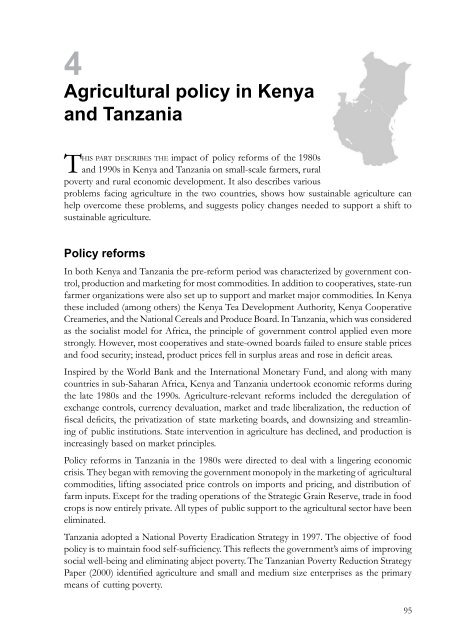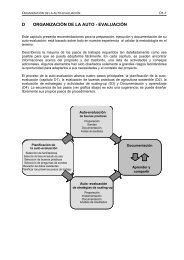cases from tanzania - Sustainet
cases from tanzania - Sustainet
cases from tanzania - Sustainet
You also want an ePaper? Increase the reach of your titles
YUMPU automatically turns print PDFs into web optimized ePapers that Google loves.
4<br />
Agricultural policy in Kenya<br />
and <strong>tanzania</strong><br />
his part describes the impact of policy reforms of the 1980s<br />
tand<br />
1990s in Kenya and Tanzania on small-scale farmers, rural<br />
poverty and rural economic development. It also describes various<br />
problems facing agriculture in the two countries, shows how sustainable agriculture can<br />
help overcome these problems, and suggests policy changes needed to support a shift to<br />
sustainable agriculture.<br />
policy reforms<br />
In both Kenya and Tanzania the pre-reform period was characterized by government control,<br />
production and marketing for most commodities. In addition to cooperatives, state-run<br />
farmer organizations were also set up to support and market major commodities. In Kenya<br />
these included (among others) the Kenya Tea Development Authority, Kenya Cooperative<br />
Creameries, and the National Cereals and Produce Board. In Tanzania, which was considered<br />
as the socialist model for Africa, the principle of government control applied even more<br />
strongly. However, most cooperatives and state-owned boards failed to ensure stable prices<br />
and food security; instead, product prices fell in surplus areas and rose in deficit areas.<br />
Inspired by the World Bank and the International Monetary Fund, and along with many<br />
countries in sub-Saharan Africa, Kenya and Tanzania undertook economic reforms during<br />
the late 1980s and the 1990s. Agriculture-relevant reforms included the deregulation of<br />
exchange controls, currency devaluation, market and trade liberalization, the reduction of<br />
fiscal deficits, the privatization of state marketing boards, and downsizing and streamlining<br />
of public institutions. State intervention in agriculture has declined, and production is<br />
increasingly based on market principles.<br />
Policy reforms in Tanzania in the 1980s were directed to deal with a lingering economic<br />
crisis. They began with removing the government monopoly in the marketing of agricultural<br />
commodities, lifting associated price controls on imports and pricing, and distribution of<br />
farm inputs. Except for the trading operations of the Strategic Grain Reserve, trade in food<br />
crops is now entirely private. All types of public support to the agricultural sector have been<br />
eliminated.<br />
Tanzania adopted a National Poverty Eradication Strategy in 1997. The objective of food<br />
policy is to maintain food self-sufficiency. This reflects the government’s aims of improving<br />
social well-being and eliminating abject poverty. The Tanzanian Poverty Reduction Strategy<br />
Paper (2000) identified agriculture and small and medium size enterprises as the primary<br />
means of cutting poverty.<br />
95




